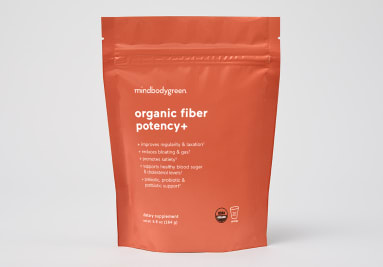The Average US Adult Isn't Meeting The Daily Fiber Needs For A Toddler


Americans aren't coming close to meeting their dietary fiber needs. In fact, the average U.S. adult isn't even meeting the daily fiber recommendation for a toddler: According to the National Academies, children between 1 and 3 should be getting 19 grams of fiber per day. Meanwhile, most American adults are getting only 16 grams1.
How did we end up with this nutrient gap of epic proportions? And how do we fix it?
Why Americans are failing to get enough fiber.
Looking at the standard American diet, it's clear that fiber is low on the list of priorities.
After all, it's near impossible to meet your daily fiber requirements when your meals are high in saturated fat, meat, and processed grains but low in fiber-rich foods like fruits, vegetables, whole grains, and legumes.
The American plate is shockingly void of plant foods, and thus, dietary fiber. As a result, a whopping 95% of American adults and children2 are failing to meet their daily fiber needs. Fiber is critical for whole-body health—it promotes healthy digestion, bowel movements, immune response, cardiovascular function, metabolic well-being, and more. Translation? Not getting enough is a big deal.
How much daily fiber do you actually need?
Here, we've outlined the daily fiber needs of adults. These are baseline levels for adequacy (i.e., you could shoot for even more) as determined by the National Academies:
Women
- Ages 19-50: 25 grams
- Over 51: 21 grams
- Pregnant: 28 grams
- Lactating: 29 grams
Men
- Ages 19-50: 38 grams
- Over 51: 30 grams
Note: Again, these recommendations are the adequate intake, aka the minimum amount you should be consuming per day. You can certainly exceed these recommendations safely, but be sure to drink at least 8 ounces of water for every 25 grams of fiber you consume to further support your digestion and gut motility.
How to increase your fiber intake.
Since our bodies cannot synthesize fiber, the only way to get this essential complex carb is through diet or supplementation. To ensure you're meeting your daily fiber requirements, add fiber-rich foods (like whole grains, fruits, vegetables, legumes, nuts, and seeds) to each meal of the day.
If you're still struggling to meet your recommended daily intake (and most Americans are), consider a premium fiber supplement to ensure you're getting sufficient dietary fiber. We recommend a high-quality fiber powder (as that will provide the most meaningful dose of fiber with the fewest additives) that delivers a high-potency dose (at least 6 grams) of fiber.
mindbodygreen's organic fiber potency+ delivers 6 grams of plant-powered functional fibers from organic guar bean, kiwifruit, and mushrooms. This USDA-certified organic blend of soluble, insoluble, and prebiotic fibers is unflavored to mix seamlessly with your beverage or meal of choice. The addition of resilient Bacillus subtilis probiotic strain adds to the already impressive lineup of fiber-rich ingredients to deliver comprehensive gut health support for you and your family.*
The takeaway.
The average U.S. adult isn't even meeting toddler daily fiber recommendations. To bridge this serious nutrient gap, add more fiber-rich foods to your daily meals and consider a high-quality fiber supplement (like mindbodygreen's organic fiber potency+) to ensure you're getting enough fiber to support your gut, heart, metabolic health, and overall well-being.*

Morgan Chamberlain is a supplement editor at mindbodygreen. She graduated from Syracuse University with a Bachelor of Science degree in magazine journalism and a minor in nutrition. Chamberlain believes in taking small steps to improve your well-being—whether that means eating more plant-based foods, checking in with a therapist weekly, or spending quality time with your closest friends. When she isn’t typing away furiously at her keyboard, you can find her cooking in the kitchen, hanging outside, or doing a vinyasa flow.

